
Le Mans
Many motorports fans love close racing and a tight finish. What could be better than wheel to wheel racing? In fact many race series nowadays try to ensure just such a spectacle, with restrictive rules, and even what to some might be seen as artificial handicaps.
Manufacturers on the other hand, tend to prefer clear superiority, and crushing dominance, especially if their cars are the ones achieving that. After all, the prestige of their companies are at stake, and perhaps even the hopes of a nation.
Sometimes there is even more at stake, sometimes there are deeply held personal grudges to settle at the highest level. This is the story of one such occasion, when a grudge match entwined with a fight between two famous companies and two nations to light up the 1960s.
But it's not a story of close racing, it is a story of one manufacturer overcoming the clear superiority of another, and achieving complete dominance over them.
Ferrari
Our story begins with Ferrari at the dawn of the 1960s, when they were primarily a racing team who sold exclusive sports cars to finance their motorsports endeavours.
By 1960 Ferrari had won the Formula 1 World Championship four times, and the World Championship for sports cars five times. They had already won Le Mans three times and were just about to complete an unprecedented run of five consecutive victories at the Circuit de la Sarthe from 1960-65, a feat unmatched until twenty years later. In fact Ferrari didn't just win in that period, more often than not they completely dominated the top end of the classification.
Ferrari's technical expertise was undoubted, it's name was revered, and it's experience in building some of the most desirable sports cars in the world was coveted by one of the world's largest car manufacturers.
Ford
Ford were desperately looking for a way to turn the tide of dwindling sales. Top executives, including Lee Iacocca, convinced Henry Ford II that the answer was a sports car.
Since Ford didn't have a sports car, the obvious solution was to buy a company that did. So Ford approached Ferrari, and Enzo Ferrari was reportedly keen to be rid of the day to day running of the road car business. After months of negotiations, in 1962 a deal seemed close.
But Enzo had a change of heart when he realised that the deal meant handing over control of his racing team. So he pulled out of the deal at the last minute, after Ford had spent several million dollars in an audit of Ferrari factory assets and in legal negotiations.
To add insult to injury quite literally, Enzo also insulted Ford, both the man and the company, and then sold a majority share in Ferrari to Italian manufacturer Fiat, leaving Ford with the suspicion that they had been used to bump up Ferrari's price.
So whilst Ferrari were completing their run of five Le Mans victories, Henry Ford II was plotting revenge. He was determined to beat Ferrari at Le Mans, and was supposed to have spent 25 million dollars on the project to achieve it, somewhat dwarfing the $10m he offered Ferrari to buy them out. It was personal.
Circuit de la Sarthe
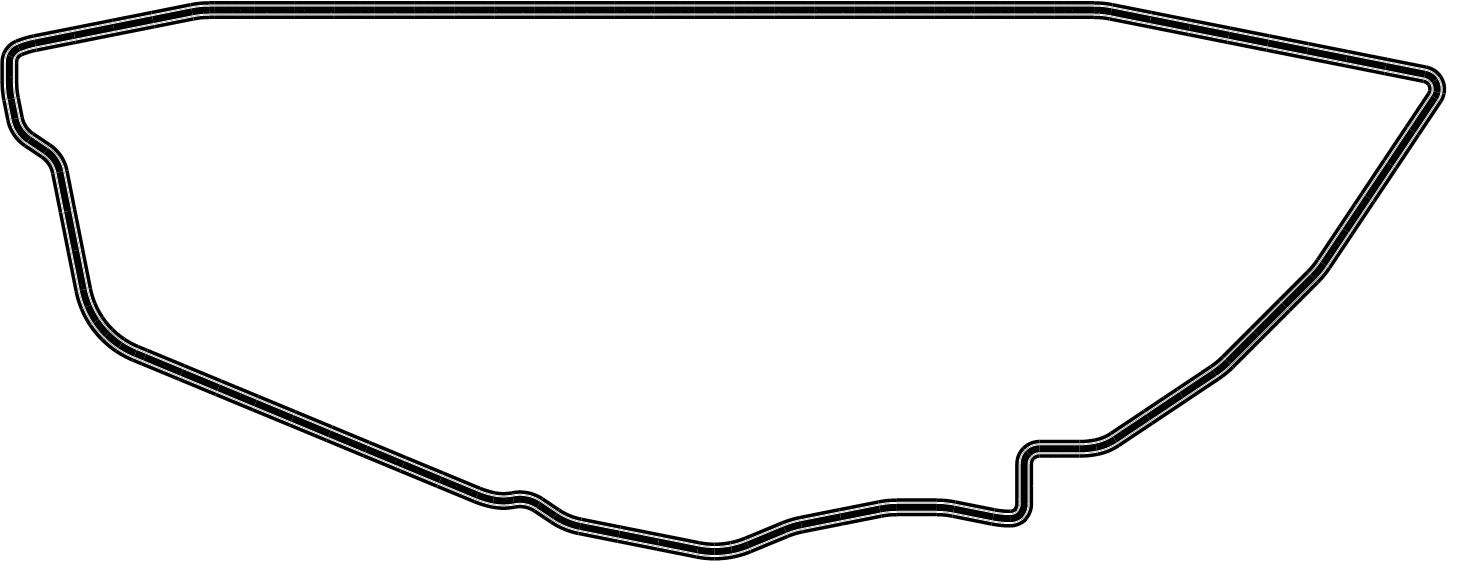
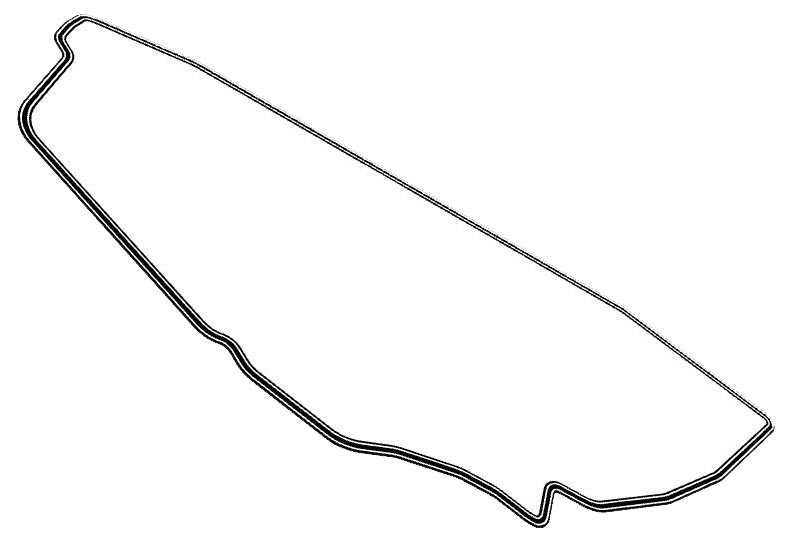
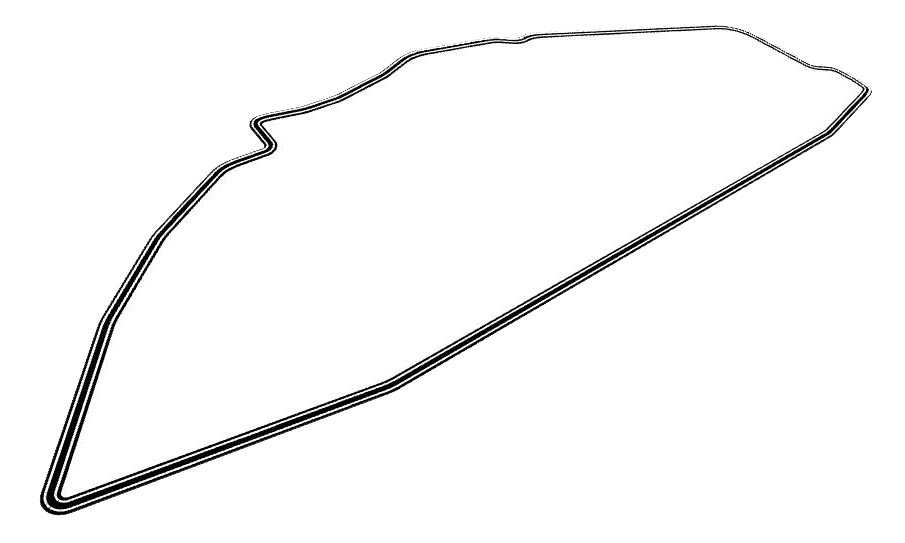

| 10105 | x3 |
| 10104 | x1 |
| 10113 | x2 |
| 10103 | x4 |
| 10102 | x67 |
| 10115 | x20 |
| 10116 | x1 |
| 10108 | x1 |
| 10107 | x2 |
| 10106 | x7 |
The Track
Circuit de la Sarthe has been the venue of the 24 Heures du Mans since 1923. At over 8 miles (13km) long it is one of the longest circuits in the world, and it is said that up to 85% of the lap is spent at full throttle, putting immense stress on the engine and drivetrain components.
A short section of the track, from the start line through the Dunlop corner and the Dunlop chicane, are part of the Bugatti circuit, but most of the rest of the track uses public roads.
The circuit has undergone many modifications over the years, but even with those modifications in place, prototype cars can achieve average lap speeds in excess of 240 km/h (150 mph) and have reached maximum speeds of over 400km/h (250mph).
Ford GT
To set out to beat the dominant Ferraris at Le Mans was one thing, but with so little experience of building mid engined sports cars, it would be another thing altogether to achieve that aim. Ford turned to Eric Broadley, owner and chief designer of Lola whose talent and experience would serve them well.
Broadley agreed to a temporary, one year contract to design and build the first Ford GTs. His Lola Mk6 already used a Ford V8 engine and had performed creditably at Le Mans in 1963, even though the car had gearbox problems, and crashed out when the gearbox finally jammed.
The Ford GT was built around a Lola chassis, and was fairly quick straight away, though somewhat unreliable. The car was running second in its first race at the Nürburgring 1000 km when the suspension failed, and at Le Mans Richie Ginther led the race until his first pit stop, but none of the three Ford GT40s finished the race.
After a season long series of dismal results under John Wyer in 1964, the program was handed over to Carroll Shelby. Despite a promising start with a win at Daytona, and a second place at Sebring the rest of the 1965 season was a disappointment.
For 1966 The Ford GT40 was fitted with a much larger 7 litre (427 ci) engine from the Ford Galaxie, and a more reliable gearbox. Much work had also been done to improve the aerodynamics, brakes, and handling. The MkII Ford GT40 was a winner, finishing 1-2-3 at both Daytona and Sebring, but Le Mans was the big prize that Ford were chasing.
Le Mans Progammes

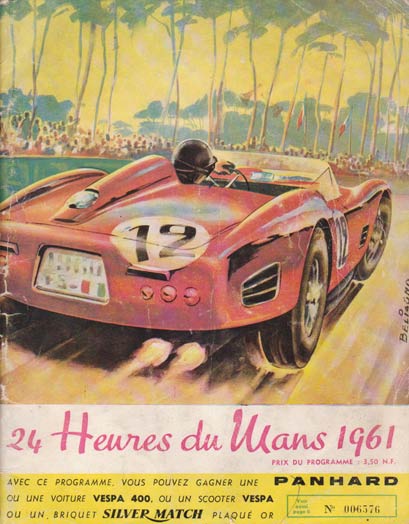
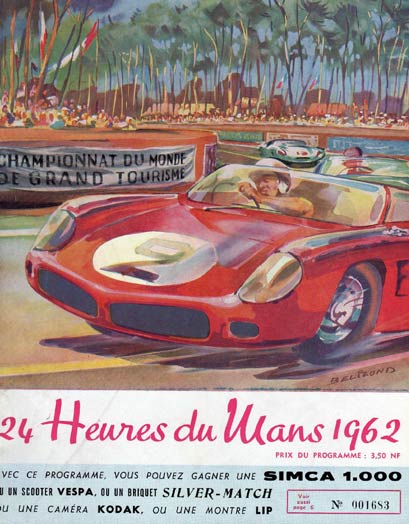
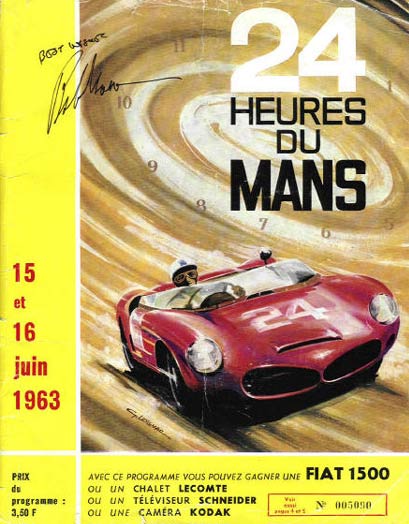
Le Mans
No fewer than fifteen GT40s were entered for Le Mans. Eight entries were accepted by the ACO, though only seven started the race after Walt Hansgen crashed in practise and died in hospital several days later.
Ferrari had even more entrants, fourteen in total, with a range of 250s, 275s, 330s, 365s, and Dino 206s. All were lighter, nimbler, but less powerful than the Ford GT40s.
Come race day the weather was cool and cloudy, and Henry Ford II himself started the race.
At the end of the first lap Ford's cars led with Hill ahead of Gurney and Bucknum.
On the third lap Gurney took the lead, and at the end of the first hour Fords were still 1-2-3. At dusk it started to drizzle, reducing the power advantage of the big Fords, and allowing the Ferraris to keep in touch.
After 6 hours, heavy rain was pouring down. Ginther's NART Ferrari was leading from Parkes, chased by the Fords of Miles and Gurney on the same lap. As the rain eased, the Fords retook the lead.
During the night the Ferraris started to suffer from overheating. When the NART P3 retired from 4th with a broken gearbox at 3am, and the Filipinetti car of Mairesse/Müller from 5th an hour later, the Ferrari challenge was spent – there would be no privateer-saviours for the marque this year.
At the halfway point the Ford GT40s held the top 8 places in the race. The nearest Ferrari was the Bandini/Guichet P3 limping in 12th.
What could have been a procession for Ford proved to be anything but. By 9am retirements meant that Ford only had three cars left in the race. Fortunately they were placed first, second, and third. The finish though proved controversial
Leo Beebe, Ford racing director, wanted to stage a dead heat by having his two lead cars cross the line simultaneously. But the ACO told him this would not be possible. Given the staggered starting formation, the #2 car would have covered 20 metres further, and thus be the race winner. But Beebe pushed on with his plan anyway. Miles was told to ease off to allow McLaren to catch up with him. As it turned out McLaren's #2 car crossed the finish line just ahead and was declared the winner. It was rumoured that Miles, upset about the team orders, lifted off to allow McLaren to finish a length ahead.
The Ford team's decision was a big disappointment for Ken Miles. "I'm disappointed, of course, but what are you going to do about it?" Beebe also later admitted he had been annoyed with Miles racing Gurney, disregarding team orders by potentially risking the cars’ endurance. Two months later, Ken Miles was killed at Riverside while testing the next generation Ford GT40 J-Car, which became the MkIV that won Le Mans in 1967.
8 Metres
Press Release
Official Ford Press Release
The McLaren-Amon and the Miles-Hulme cars were running within seconds of each other as the race neared its end, with the Bucknum-Hutcherson car hanging back as insurance. A decision was made in the Ford pits to have the cars finish side by side in what hopefully would be considered a dead heat. All three cars went over the finish in formation, but any chance for a dead heat disappeared when officials discovered a rule that in case of a tie, the car that had started further down the grid had travelled the farther distance. Since McLaren and Amon had started 60 feet behind Miles and Hulme, they were declared the winners.
Both New Zealanders who now reside in England, it was the most important victory yet for the two youngsters. McLaren, who builds his own Formula and sports cars, is 28. Amon 22, is the youngest winner in the history of the event.
It was a record shattering performance as the winning car covered more miles (3,009.3) at a faster speed (125.38 mph) than any previous entry. It demonstrated that production engines could compete with racing powerplants and that an American built* car could top Europe's best
* Note - The Ford GT40 MkI-MkIIIs were actually built in Britain. Only the MkIV was built in America.
Lost Footage 1966 Le Mans
Success
Ford went on to further success at Le Mans, winning in 1967, 68 & 69.
In 1967 Ford introduced the MkIV GT40, the first to be built in America, and though it only ran in two races, it won both, at Sebring and Le Mans. The 1967 Le Mans victory was not so dominant as the previous year though, with Ferrari finishing second and third.
In 1968, rule changes meant that both the MkIII & MkIV GT40s were inelegible, and so were the Ferrari 330P4s. Ford's factory team pulled out, leaving John Wyer to run a much modified MkI version of the GT40, and Ferrari also pulled out for two years. Ford won again, with Porsche in second and third places.
Wyer, one of the original development team for the GT40, ran the cars again in 1969 and finished first and third. After being beaten by a supposedly obsolete car, Porsche contracted John Wyer and his Gulf-J.W. Automotive Team to become the official works supported team and development partner in 1970.
And so the GT40's four year success story was over. Ford had indeed beaten Ferrari at Le Mans. In fact Ferrari never won at Le Mans again, and Ford didn't return until 2016 when the new GT finished first in class on the 50th anniversary of their famous 1966 victory.
